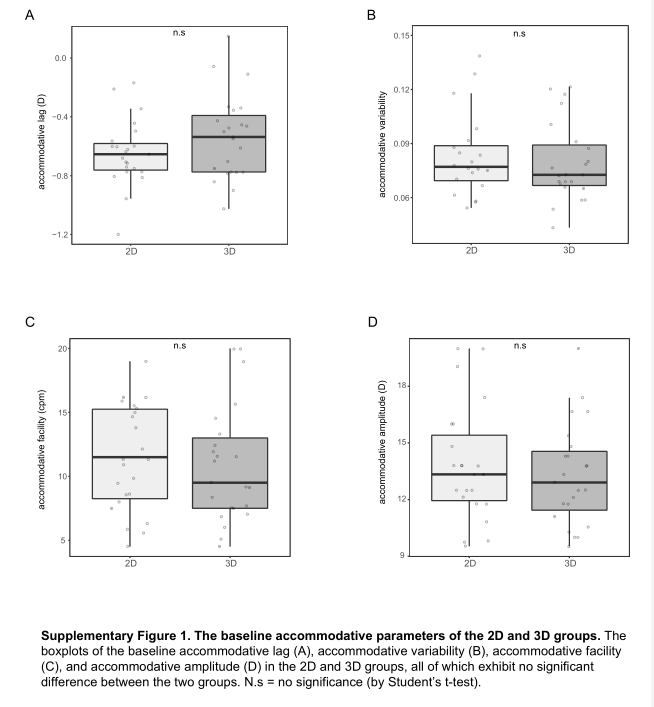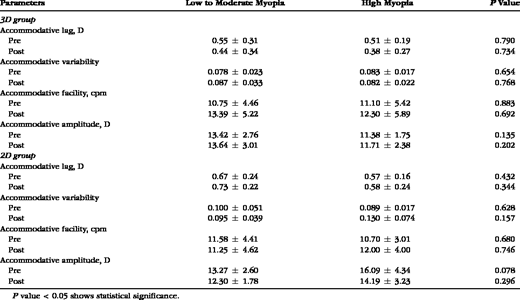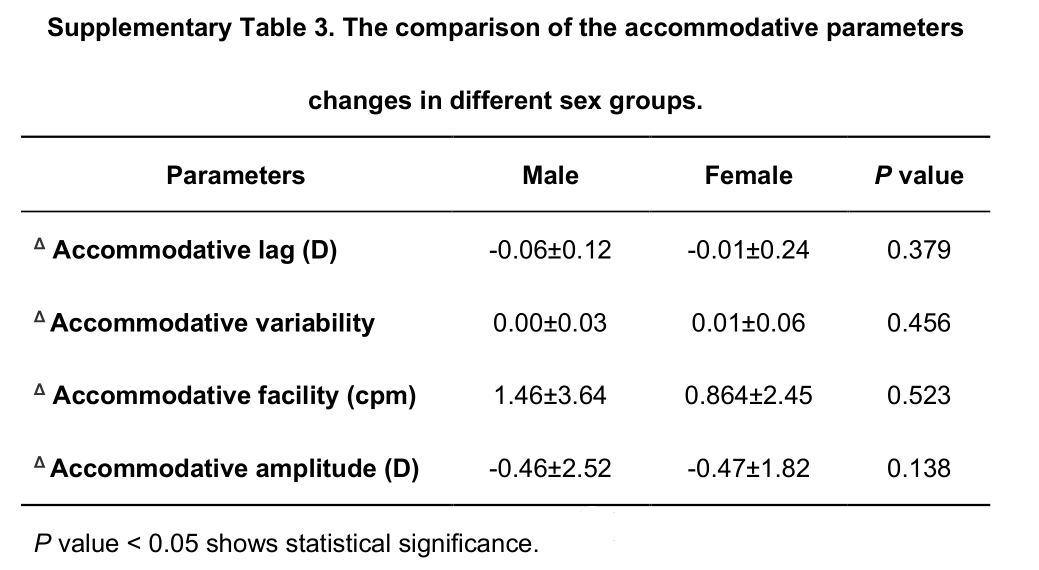

Study of the Immediate Effects of Autostereoscopic 3D Visual Training on the Accommodative Functions of Myopes
Highlights
In recent years, with the rapid development of display devices and technologies, autostereoscopic 3D technology, as an emerging technology, has been widely studied and applied in the filed of human vision science. The main directions are the improvement of visual function, the relief of visual fatigue and the effectiveness of myopia prevention and control.
The teams of professor Zhou Xingtao, the dean of Eye & ENT Hospital, Fudan University, Shanghai, China, conducted a study on the immediate effect of autostereoscopic 3D visual training on the accommodative function of Myopes. The article was recently published in the internationally renowned academic journal Investigative Ophthalmology & Visual Science (IOVS). The researchers randomly divided the participants into 2D visual training and autosteroscopic 3D visual training groups. Both groups underwent 11-minute visual training with carefully designed content. The researchers adjusted functional parameters before, during and immediately after training. Measurements were performed and the degree of visual fatigue was subjectively assessed by questionnaires after training. The results showed that after training, the adjustment lag of the autostereoscopic visual 3D training group was significantly reduced, and the adjustment sensitivity was significantly increased; while the adjustment amplitude of the 2D visual training group was decreased. The overall visual fatigue of the two groups of subjects after training was lower than fatigue of the usual daily study and work.
It’s exciting that accommodative lag and low accommodation sensitivity has been widely confirmed by the academic community that the transient or long-term hyperopic defocus caused by them is closely related to the occurrence and development of myopia. We can boldly speculate that autostereoscopic visual 3D training may become an effective solution for myopia prevention and control!
We look forward to more exploration and research in this filed!
Abstract
Purpose: Stereoscopic viewing has an impact on ocular dynamics, but its effects on accommodative functions are not fully understood, especially for autostereoscopic viewing. This study aimed to investigate the changes in dynamic accommodative response, accommodative amplitude, and accommodative facility of myopes after autostereoscopic visual training.
Methods: We enrolled 46 adults (men = 22 and women = 24; age = 21.5 ± 2.5 [range = 18–25] years, spherical equivalent: −4.52 ± 1.89 [−8.88 to −1.75] diopters [D]) who visited the Eye & ENT Hospital of Fudan University. The study population was randomly divided into three-dimensional (3D) and two-dimensional (2D) viewing groups to watch an 11-minute training video displayed in 3D or 2D mode. Dynamic accommodative response, accommodative facility, and accommodative amplitude were measured before, during, and immediately after the training. Accommodative lag and the variability of accommodation were also analyzed. Visual fatigue was evaluated subjectively using a questionnaire.
Results: Accommodative lag decreased from 0.54 ± 0.29 D to 0.42 ± 0.32 D (P = 0.004), whereas accommodative facility increased from 10.83 ± 4.55 cycles per minute (cpm) to 13.15 ± 5.25 cpm (P < 0.001) in the 3D group. In the 2D group, there was no significant change in the accommodative lag (P = 0.163) or facility (P = 0.975), but a decrease in accommodative amplitude was observed (from 13.88 ± 3.17 D to 12.71 ± 2.23 D, P = 0.013). In the 3D group, the accommodative response changed with the simulated target distance. Visual fatigue was relatively mild in both groups.
Conclusions: The immediate impact of autostereoscopic training included a decrease in the accommodative lag and an increase in the accommodative facility. However, the long-term effects of autostereoscopic training require further exploration.
Introduction
The impact of autostereoscopic display on the human visual system has been extensively studied since the first advent of stereoscopic display technology. Asthenopia is a major concern in these studies and is generally believed to be caused by accommodation vergence mismatch (ie, invariant accommodative stimuli (AS) conflict with changing vergence stimuli). A number of studies have also evaluated the effects of stereoscopic viewing and have shown that stereoscopic viewing can lead to reduced ensemble accommodation and ensemble ratios, reduced accommodation amplitude, disturbance of accommodative and ensemble juxtapositions, and shortened tear film break-up time. At present, most of the research objects are traditional 3D display technology, but little is known about autostereoscopic 3D display technology using lens plates. In addition, the changes of adjustment hysteresis and adjustment sensitivity after stereoscopic display viewing are unclear. Since accommodation may play a role in the development of myopia, it is important to study the effects of stereoscopic viewing or accommodation training on myopia. Therefore, this study aimed to evaluate the immediate effects of autostereoscopic 3D vision training on accommodation parameters in myopic patients by comparing with two-dimensional (2D) viewing, paving the way for further exploration of whether autostereoscopic 3D viewing affects the development of myopia.

The autostereoscopic 3D display equipment
Result
Table 1: Baseline Characteristics of the Participants. There were no significant differences in gender, age, diopter, intraocular pressure, and axial length between the 2D group and the 3D group.

Baseline Characteristics of the Participants
Supplementary Table 1: The baseline accommodative parameters of the 2D and 3D groups.
There was no significant difference in baseline accommodative parameters between the 2D and 3D groups.

The baseline accommodative parameters of the 2D and 3D groups
Table 2: Accommodative Parameters Pre- and Post-Viewing Task. The data showed that accommodation lag was significantly reduced in the 3D viewing group, while accommodation sensitivity increased significantly, with no significant changes observed in accommodation variability and accommodation amplitude. The adjustment range of the 2D viewing group decreased, and other adjustment parameters did not change significantly.

Accommodative Parameters Pre- and Post-Viewing Task
Table 3: Changes of Accommodative Functions in Different Refractive Groups. Participants were divided into low and moderate myopia group and high myopia group according to the refraction for further analysis. Baseline data between the two groups showed only significant differences in refractive status and axial length. There were no significant differences in the adjustment parameters between the two groups before and after the experiment.

Changes of Accommodative Functions in Different Refractive Groups.
Supplementary Table 3: The comparison of the accommodative parameters changes in different sex groups. Further analysis of the participants by gender showed that there was no significant difference in the adjustment parameters of males and females before and after viewing.

The comparison of the accommodative parameters changes in different sex groups.
Figure 4: Changes in dynamic accommodative responses between the first cycle and the last cycle. (A) The 3D group. (B). The 2D group.The accommodative responses of the 3D group varied with the simulated observation distance of the fluctuating optotype "E". The accommodative responses in the 2D group did not follow the size of the optotype "E". In addition, both groups showed an increase in accommodative responses, but the increase in the 2D group (about 0.04 D) was smaller than that in the 3D group (about 0.1 D).

Changes in dynamic accommodative responses between the first cycle and the last cycle. (A) The 3D group. (B)The 2D group.
Figure 5: The subjective evaluation of visual fatigue. (A) Scores of each symptom. (B) General visual fatigue after the viewing task (“after viewing”) and in everyday life (“during study or work”).After viewing, participants in the 3D group mainly reported symptoms as ghosting and dry eye. Dry eye was the most serious in the 2D group, followed by eye fatigue. There was no significant difference in the severity of symptoms between the two groups. However, the overall visual fatigue level "after viewing" in both groups of experiments was significantly lower than the daily level of visual fatigue "during study or work".

The subjective evaluation of visual fatigue. (A) Scores of each symptom. (B) General visual fatigue after the viewing task (“after viewing”) and in everyday life (“during study or work”).
In conclusion, the immediate impact of autostereoscopic 3D training included a decrease in accommodative lag and an increase in accommodative facility. Based on our findings, it can be assumed that autostereoscopic technology may be useful for improving the accommodative functions of myopes. However, the long-term effects of autostereoscopic training require further exploration.